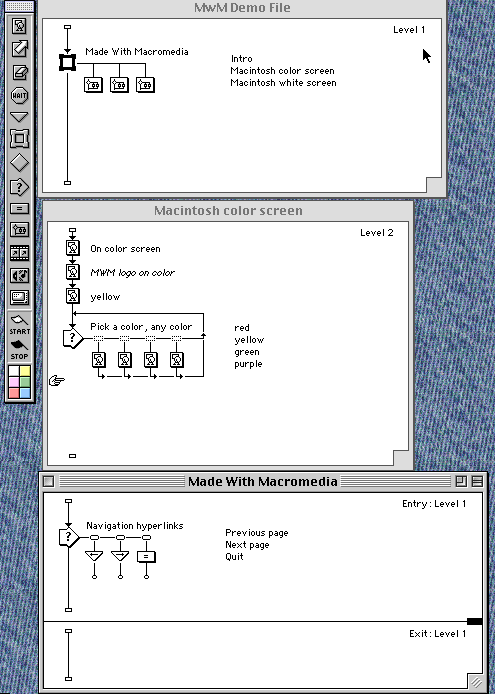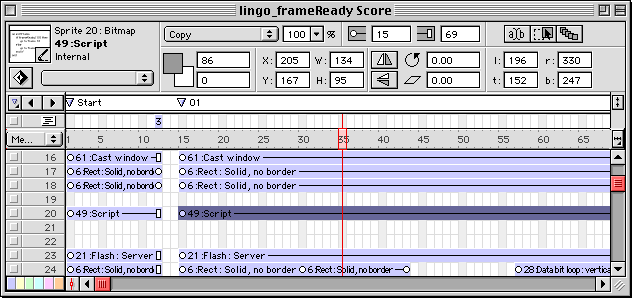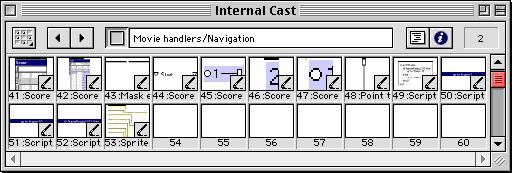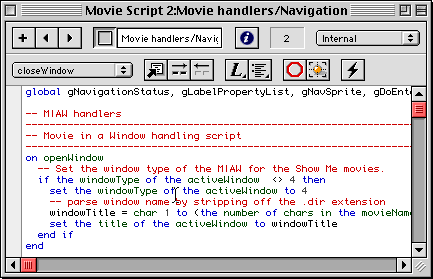


Next: Multimedia Programming vs Multimedia
Up: Multimedia Authoring:Systems and Applications
Previous: Why should you use
The authoring paradigm, or authoring metaphor, is the
methodology by which the authoring system accomplishes its task.
There
are various paradigms, including:
- Scripting Language
- -- the Scripting paradigm is the authoring
method closest in form to traditional programming. The paradigm is that
of a programming language, which specifies (by filename) multimedia
elements, sequencing, hotspots, synchronization, etc. A powerful,
object-oriented scripting language is usually the centerpiece of such a
system; in-program editing of elements (still graphics, video, audio,
etc.) tends to be minimal or non-existent. Scripting languages do vary;
check out how much the language is object-based or object-oriented. The
scripting paradigm tends to be longer in development time (it takes
longer to code an individual interaction), but generally more powerful
interactivity is possible. Since most Scripting languages are
interpreted, instead of compiled, the runtime speed gains over other
authoring methods are minimal. The media handling can vary widely; check
out your system with your contributing package formats carefully.
The Apple's HyperTalk for HyperCard, Assymetrix's OpenScript for
ToolBook and Lingo scripting language of Macromedia Director are examples
of a Multimedia scripting language.
Here is an example lingo script to jump to a frame
global gNavSprite
on exitFrame
go the frame
play sprite gNavSprite
end
- Iconic/Flow Control
- -- This tends to be the speediest (in development time) authoring style; it is best suited for rapid prototyping and short-development time
projects. Many of these tools are also optimized for developing Computer-Based Training (CBT). The core of the paradigm is the
Icon Palette, containing the possible functions/interactions of a program, and the Flow Line, which shows the actual links between the
icons. These programs tend to be the slowest runtimes, because each interaction carries with it all of its possible permutations; the
higher end packages, such as Authorware (Fig. 2.1)or IconAuthor, are
extremely powerful and suffer least from runtime speed problems.

Macromedia Authorware Iconic/Flow Control Examples
- Frame
- -- The Frame paradigm is similar to the Iconic/Flow Control paradigm in
that it usually incorporates an icon palette; however, the links drawn between icons
are conceptual and do not always represent the actual flow of the program. This is a
very fast development system, but requires a good auto-debugging function, as it is
visually un-debuggable. The best of these have bundled compiled-language scripting,
such as Quest (whose scripting language is C) or Apple Media Kit.
- Card/Scripting
- -- The Card/Scripting paradigm provides a great deal of power
(via the incorporated scripting language) but suffers from the index-card structure.
It is excellently suited for Hypertext applications, and supremely suited for
navigation intensive (a la Cyan's "MYST" game) applications. Such programs are easily
extensible via XCMDs and DLLs; they are widely used for shareware applications. The
best applications allow all objects (including individual graphic elements) to be
scripted; many entertainment applications are prototyped in a card/scripting system
prior to compiled-language coding.
- Cast/Score/Scripting
- -- The Cast/Score/Scripting paradigm uses a music score
as its primary authoring metaphor; the synchronous elements are shown in various
horizontal tracks with simultaneity shown via the vertical columns. The true
power of this metaphor lies in the ability to script the behavior of each of the cast
members. The most popular member of this paradigm is Director, which is used in the
creation of many commercial applications. These programs are best suited for
animation-intensive or synchronized media applications; they are easily extensible to
handle other functions (such as hypertext) via XOBJs, XCMDs, and DLLs.
Macromedia Director uses this method and examples can be found in
Figs 2.2-- 2.4

Macromedia Director Score Window

Macromedia Director Cast Window

Macromedia Director Script Window
- Hierarchical Object
- -- The Hierarchical Object paradigm uses a object
metaphor (like OOP) which is visually represented by embedded objects and iconic
properties. Although the learning curve is non-trivial, the visual representation of
objects can make very complicated constructions possible.
- Hypermedia Linkage
- -- The Hypermedia Linkage paradigm is similar to the Frame
paradigm in that it shows conceptual links between elements; however, it lacks the
Frame paradigm's visual linkage metaphor.
- Tagging
- -- The Tagging paradigm uses tags in text files (for instance,
SGML/HTML, SMIL (Synchronised Media Integration Language), VRML, 3DML and WinHelp) to
link pages, provide interactivity and integrate multimedia elements.



Next: Multimedia Programming vs Multimedia
Up: Multimedia Authoring:Systems and Applications
Previous: Why should you use
Dave Marshall
10/4/2001



